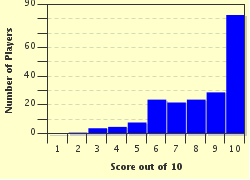Quiz Answer Key and Fun Facts
1. The traditional music of Ghana differed between northern and southern Ghana. In northern Ghana music was played on various stringed, wind, and percussion instruments. Which is NOT one of these traditional indigenous instruments of West Africa?
2. A common feature of traditional northern Ghanaian music is singing one syllable of text across several notes. What is this called?
3. The traditional music of southern Ghana, particularly along the coast, is more closely related to social functions. It often uses complex cross-rhythmic patterns, often three beats over two. What is another name for this?
4. The rhythms are simpler in the Akan tradition of singing with a harp-lute, usually done by a griot, person who once fulfilled a multitude of functions. What would a griot LEAST likely be?
5. Funerals in Ghana often last for days, and move from mourning loss to celebrating life, even procreation.
6. During the Gold Coast period (1821-1957), there grew a fusion of African rhythms and Western music known as highlife, with roots in brass marching bands and the music of palm wine sea shanties. Many kinds of Western and African instruments were played; which was LEAST likely in the early twentieth century?
7. Highlife is often viewed as pre-Independence music. Post-Independence music spelled the gradual overtaking of highlife with music styles (R&B, pop, soul, reggae) directly imported from the Americas, which culminated in the 1971 Soul to Soul Music Festival in Accra that featured only black American stars, except for which artist?
8. By the 1980s, immigration laws changed in the UK, and many Ghanaians who would have emigrated to Britain opted instead for a different European country. Once there, they created a fusion of African and European music known as Burgher-highlife. Where did they go to create this new style?
9. In the 1990s, the new musical style from Ghana was hiplife, a fusion of _____ and _____.
10. Hiplife music is rarely performed with live instruments before an audience.
Source: Author
gracious1
This quiz was reviewed by FunTrivia editor
agony before going online.
Any errors found in FunTrivia content are routinely corrected through our feedback system.

